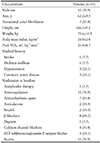1. Osbak PS, Mourier M, Kjaer A, Henriksen JH, Kofoed KF, Jensen GB. A randomized study of the effects of exercise training on patients with atrial fibrillation. Am Heart J 2011;162(6):1080-1087.


2. Hegbom F, Stavem K, Sire S, Heldal M, Orning OM, Gjesdal K. Effects of short-term exercise training on symptoms and quality of life in patients with chronic atrial fibrillation. Int J Cardiol 2007;116(1):86-92.


3. Lee SR, Choi EK, Han KD, Cha MJ, Oh S. Trends in the incidence and prevalence of atrial fibrillation and estimated thromboembolic risk using the CHA
2DS
2-VASc score in the entire Korean population. Int J Cardiol 2017;236:226-231.


4. Eckel RH, Jakicic JM, Ard JD, de Jesus JM, Houston Miller N, Hubbard VS, et al. 2013 AHA/ACC guideline on lifestyle management to reduce cardiovascular risk: a report of the American College of Cardiology/American Heart Association Task Force on Practice Guidelines. J Am Coll Cardiol 2014;63(25 Pt B):2960-2984.

5. Malmo V, Nes BM, Amundsen BH, Tjonna AE, Stoylen A, Rossvoll O, et al. Aerobic interval training reduces the burden of atrial fibrillation in the short term: a randomized trial. Circulation 2016;133(5):466-473.


6. Ega├▒a M, Columb D, O'Donnell S. Effect of low recumbent angle on cycling performance, fatigue, and V┬ĘO(2) kinetics. Med Sci Sports Exerc 2013;45(4):663-673.


7. Kim SD, Jeong IG, Koh YS, Lee HH. Effects of recumbent angle during cycling on cerebral blood flow velocity and rate pressure product during exercise and recovery. Korean J Health Promot 2019;19(3):155-160.


9. Bonzheim SC, Franklin BA, DeWitt C, Marks C, Goslin B, Jarski R, et al. Physiologic responses to recumbent versus upright cycle ergometry, and implications for exercise prescription in patients with coronary artery disease. Am J Cardiol 1992;69(1):40-44.


10. Bettoni M, Zimmermann M. Autonomic tone variations before the onset of paroxysmal atrial fibrillation. Circulation 2002;105(23):2753-2759.


11. Fioranelli M, Piccoli M, Mileto GM, Sgreccia F, Azzolini P, Risa MP, et al. Analysis of heart rate variability five minutes before the onset of paroxysmal atrial fibrillation. Pacing Clin Electrophysiol 1999;22(5):743-749.


12. Lombardi F, Colombo A, Basilico B, Ravaglia R, Garbin M, Vergani D, et al. Heart rate variability and early recurrence of atrial fibrillation after electrical cardioversion. J Am Coll Cardiol 2001;37(1):157-162.


13. Selig SE, Carey MF, Menzies DG, Patterson J, Geerling RH, Williams AD, et al. Moderate-intensity resistance exercise training in patients with chronic heart failure improves strength, endurance, heart rate variability, and forearm blood flow. J Card Fail 2004;10(1):21-30.

14. Malik M. Heart rate variability: standards of measurement, physiological interpretation, and clinical use: task force of the European Society of Cardiology and the North American Society for Pacing and Electrophysiology. Ann Noninvasive Electrocardiol 1996;1(2):151-181.
15. Kusunose K, Yamada H, Hotchi J, Bando M, Nishio S, Hirata Y, et al. Prediction of future overt pulmonary hypertension by 6-min walk stress echocardiography in patients with connective tissue disease. J Am Coll Cardiol 2015;66(4):376-384.


17. Parekh A, Lee CM. Heart rate variability after isocaloric exercise bouts of different intensities. Med Sci Sports Exerc 2005;37(4):599-605.


19. Kim SD, Kim MW, Kim SK, Jeong IG. The effects of recumbent bicycle ergometer exercise on cerebral blood flow velocity and BP-based arterial stiffness index. J Sport Leis Stud 2018;74(1):587-597.

20. American College of Sports Medicine. ACSM's guidelines for exercise testing and prescription: Wolters Kluwer Health. 9th ed. Baltimore: Lippincott Williams & Wilkins; 2013. p. 243-244.








 PDF Links
PDF Links PubReader
PubReader ePub Link
ePub Link Full text via DOI
Full text via DOI Download Citation
Download Citation Print
Print


